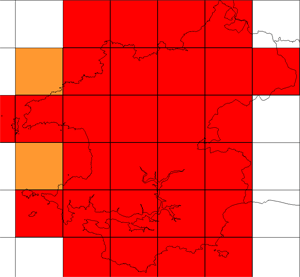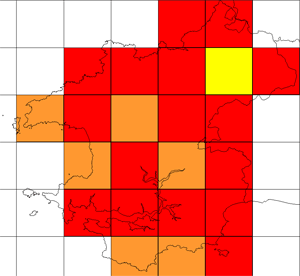Blue Tit - 1970s breeding
 Friday, November 11, 2011 at 10:19AM
Friday, November 11, 2011 at 10:19AM 
Red = breeding confirmed
Orange = breeding probable
Yellow = breeding possible
 Friday, November 11, 2011 at 10:19AM
Friday, November 11, 2011 at 10:19AM 
Red = breeding confirmed
Orange = breeding probable
Yellow = breeding possible
 Friday, November 11, 2011 at 10:08AM
Friday, November 11, 2011 at 10:08AM 
Red = breeding confirmed
Orange = breeding probable
Yellow = breeding possible
 Thursday, November 10, 2011 at 10:39PM
Thursday, November 10, 2011 at 10:39PM 
Red = breeding confirmed
Orange = breeding probable
Yellow = breeding possible
 Thursday, November 10, 2011 at 10:32PM
Thursday, November 10, 2011 at 10:32PM

Red = breeding confirmed
Orange = breeding probable
Yellow = breeding possible
 Thursday, November 10, 2011 at 10:25PM
Thursday, November 10, 2011 at 10:25PM 
Red = breeding confirmed
Orange = breeding probable
Yellow = breeding possible
 Thursday, November 10, 2011 at 10:12PM
Thursday, November 10, 2011 at 10:12PM 
Red = breeding confirmed
Orange = breeding probable
Yellow = breeding possible
 Thursday, November 10, 2011 at 6:28PM
Thursday, November 10, 2011 at 6:28PM 
This book by the Rev Murray Mathew was the first comprehensive review of birds in Pembrokeshire. It relies heavily on the Reverend's own observations and interpretations, those of a few acquaintances of his, and those from some local taxidermists.
The whole text is available to read online or download as a PDF
Only the species accounts are reproduced in this avifauna (click here to see them all - or on "Mathew" under tagged, below), there is more information in the book itself.
Note that species names are given as Mathew used them, and therefore are not always the same as in current use.
 Thursday, November 10, 2011 at 6:00PM
Thursday, November 10, 2011 at 6:00PM The Winter Atlas maps 200 species occurring in Britain and Ireland in winter. The maps are derived from surveys of birds present in Britain and Ireland during the three winters, 1981/82, 1982/83 and 1983/84. The surveys were organised by the British Trust for Ornithology and the Irish Wildbird Counsevancy, as were the earlier breeding birds surveys.
The maps reproduced here for species occurring in Pembrokeshire use the same "assessment of relative abundance" as the original maps, but are shown as light, mid and dark blue instead of different sized dots. For example, a map with light blue squares only indicates that the species is more abundant elsewhere in Britain. All maps presented for this survey are at 10-km square (Hectad resolution). A maximum of 32 10-km squares cover the Vice County. This includes partial ones along boundaries with neighbouring counties Carmarthenshire and Ceredigion and along the coast.
Detail of the methodology, and the results for the whole country, are to be found in: Lack, P.C. (1986) The atlas of wintering birds in Britain and Ireland. T. & A.D. Poyser and national maps for individual species can also be accessed from the drop-down list at the bottom of the BTO Atlas page.
All the Pembrokeshire maps can be accessed by clicking here or on the "1980s BTO winter atlas" tag below.
 Sunday, October 9, 2011 at 10:51PM
Sunday, October 9, 2011 at 10:51PM 
The BTO winter atlas showed that Yellowhammers were present in the majority of 10km squares during the winters of 1981-82, 1982-82 and 1983-84.
The darker the colour, the higher the relative total count for each 10km square. The darkest blue represents over 75 birds seen in a day.
Flocks found at a good seed source provided the largest numbers.
Graham Rees
 Sunday, October 9, 2011 at 10:50PM
Sunday, October 9, 2011 at 10:50PM 
The BTO winter atlas showed that Wrens were present in the majority of 10km squares during the winters of 1981-82, 1982-82 and 1983-84.
The darker the colour, the higher the relative total count for each 10km square. The darkest blue represents over 25 birds seen in a day.
Graham Rees
 Sunday, October 9, 2011 at 10:49PM
Sunday, October 9, 2011 at 10:49PM 
The BTO winter atlas showed that Woodpigeons were present in the majority of 10km squares during the winters of 1981-82, 1982-82 and 1983-84.
The darker the colour, the higher the relative total count for each 10km square. The darkest blue represents over 246 birds seen in a day.
Graham Rees
 Sunday, October 9, 2011 at 10:40PM
Sunday, October 9, 2011 at 10:40PM  The BTO winter atlas showed that Willow Tits were present in the majority of 10km squares during the winters of 1981-82, 1982-82 and 1983-84.
The BTO winter atlas showed that Willow Tits were present in the majority of 10km squares during the winters of 1981-82, 1982-82 and 1983-84.
The darker the colour, the higher the relative total count for each 10km square. The darkest blue represents over 6 birds seen in a day.
The plotted winter distribution was slightly less widespread than that of the breeding season possibly due to a difference in observer effort, as this species is considered to be sedentary.
Graham Rees